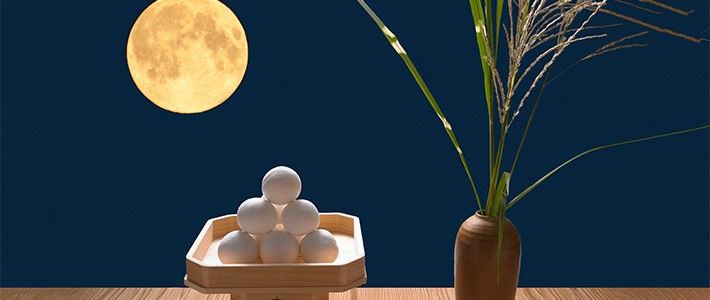Known as Tsukimi, or, Otsukimi, the “O” part is an honorific like “great” in Japanese, while “Tsukimi” means “moon-viewing” or Jugoya, which means “15th of the month” are all different names for the Japanese Mid-Autumn festival.
Tsukimi Date
Following the traditional East-Asian lunar calendar, this holiday takes place on the 15th day of the eighth lunar month. This generally falls somewhere between September and October and is analogous to other Asian Mid-Autumn festivals in many aspects.
Some traits Tsukimi shares with other Asian mid-Autumn festivals include offering thanks for a good harvest, admiring the beauty of the moon, and enjoying rice cake. However, many other aspects of Tsukimi are distinctly Japanese and can be observed only within the parameters of this unique and lovely holiday event.
Food Decorations
In Japan, a special veranda or window known as a tsukimidai or moon window is decorated with rice cakes like mochi and tsukimi dango. Tsukimi dango are rice cakes that are white and spherical, meant to represent the full moon and said to bring happiness and health. Oftentimes 12 are displayed to represent the months of the year, and stacked in a pyramidal shape atop a small and ornate pedestal.

Sweet potato, taro, edamame, and other treats represent the seasonal harvest, with the taro having the extra symbolism of a large and happy family. Not only that but Japanese pampas grass or susuki is used to decorate areas where the moon will be observed and enjoyed. The susuki grass resembles rice plants, and so symbolize a prosperous harvest.
Flower Arrangement & Tea Ceremonies
Flower arranging and tea ceremonies may also be performed or observed, too. In Japan, some individuals also light incense or perform bows or place offerings at shrines and temples, as both thanks for a lovely and bountiful harvest and to pray for a prosperous future.
Wearing Kimono
Moon-viewing picnics, composing poetry, and wearing Japanese kimono may also be part of some celebrations during this holiday event. The holiday has a seasonal appeal and lots of promotional foods and other items are on sale in Japan featuring full moon symbolism, along with imagery of the tsukimi donga in a pile, susuki grass, and the “rabbit in the moon”.
The Rabbit in the Moon
The “rabbit in the moon” is a motif originating in China, and found across Asia. Stories abound about the origins and the role of the rabbit on the moon and its significance, but generally it is understood that the stories originate from the dark craters on the moon resembling a rabbit or two pounding rice cake, hence the symbolism of the rabbit or rabbits on the moon pounding rice cake and its association with Tsukimi.
Tsukimi is a wondrous holiday celebrating the bright and luminous moon. The moon has captivated people across the world for centuries and certainly so in Japan. So, come and enjoy this beautiful and moving appreciation of the moon, and don’t forget to enjoy some rice cake and set out some pampas grass to celebrate a bountiful harvest and bright and happy future.



No Comments